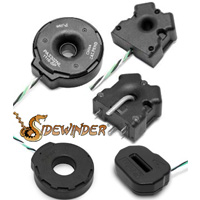By Pulse Electronics 184

Pulse Electronics Corporation introduces its new Sidewinder® AC current sensors. Sidewinder products differ from traditional current sense transformers because they do not need a core. This makes them lighter, easier to assemble, and less expensive. The sensors provide a highly linear output voltage over a very wide dynamic range from 0.1 to 1000 A, making them especially suited for applications such as distributed power generation, renewable energy and storage, load balancing, power monitoring, advanced metering infrastructure (AMI), circuit breaker panels, and smart meters.
Pulse's current sensors have a phase error of < 0.05°, a 100 KHz bandwidth, and a low temperature coefficient. They are based on the Rogowski Coil principle. Pulse Electronics' patent-pending precision winding technique controls the parameters which directly influence the output voltage in current sensors. The segmented winding approach allows for a high number of winding turns per unit length to provide a sufficiently large output voltage for detection and integration.
Sidewinder products meet the Class 0.2 percent accuracy limits defined by the IEC 62053-22 and ANSI C12.20 standards for currents from 0.1 A to 200 A and above, as well as the Class 1 requirement for immunity to external magnetic fields. They are immune to external AC magnetic fields and DC magnetic fields. The addition of a Faraday shield over the winding prevents electrostatic coupling from the AC voltage of the primary conductor and acts as an effective barrier against external electrical fields associated with nearby current-carrying conductors.
Although the standard sensor is round, as are traditional sensors in the industry, Pulse's sensors are not based on the traditional toroid core (round) shape, but on a coil configuration. The sensor can then be made in several shapes and thicknesses in addition to the traditional round shape.
ST Micro - Current Sensing in Metering Applications
Sidewinder RDT Report
Sidewinder Overview
Features